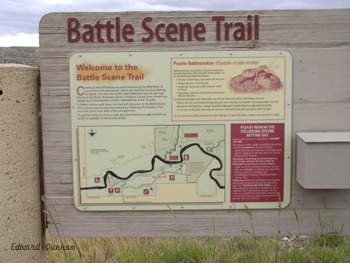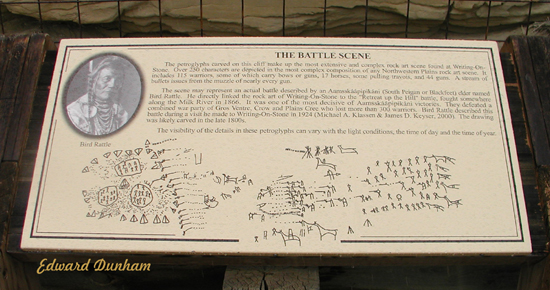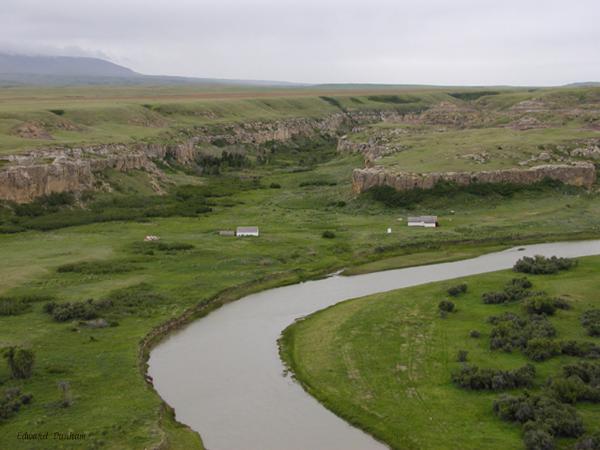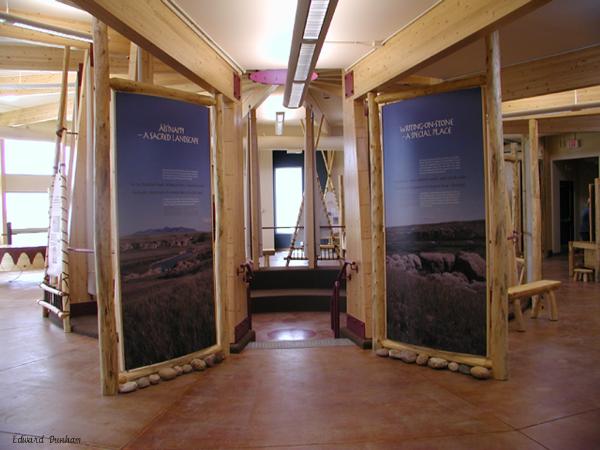"Writing on Stone" National Historic
Site: Earthcache
Writing on Stone Provincial Park and
National Historic Site is located along the Milk River 42km South
East of the town of Milk River, Alberta Canada. Writing on Stone
protects 4,400 acres of the dry mixed grass sub region of Alberta's
Grassland Natural Region. Near the Alberta - Montana border,
Writing on Stone is a unique environment of spectacular sandstone
formations along the meandering Milk River and adjacent to large
stretches of unbroken grasslands. The river winds through a wide
valley filled with an intriguing mix of cliffs, hoodoos, grassy
knolls and coulees. It is also rich in animal and plant
life.
Please when visiting this wonderful
place, remain on trails and leave no sign that you were there, take
with you only the memory and visions which will be forever etched
in your mind.

A SACRED PLACE
A wide, green valley, steep sandstone cliffs,
strange rock formations called hoodoos - all of these things
make Writing on Stone a special place. For thousands of years, this
unique environment has drawn First Nations people to Writing on
Stone. In the past, nomadic bands often returned to traditional
camping spots along the Milk River where they found shelter, water
and a great abundance of game and berries.
HISTORICAL BACKGROUND
From archaeological evidence, we know that some First Nations
people camped at Writing 0n Stone as long as 3.500 years ago.
Although some rock art may be this old, the date of its first
appearance at Writing on Stone remains uncertain. The Late
Prehistoric Period which began around 1800 years ago, First Nations
people followed the Bison herds on foot. The Shoshone and Blackfoot
are two of several groups who are possibly responsible for Late
Prehistoric rock art at Writing on Stone. The Historic Period began
circa. 1730 A.D. with the return of horses and the arrival of guns
and metal revolutionized First Nations culture. Traveling and
hunting became easier and warfare more common. Rock Art continued
to be created at Writing on Stone throughout this period. The
Blackfoot Nation controlled the Writing on Stone area during most
to the Historic Period.
THE ROCK ART Before the
introduction of metal tools most petroglyphs were incised or
scratched onto the sandstone cliffs using antlers or bones. Some
pictographs were painted with red ochre (crushed iron ore mixed
with water or bison fat), while others were drawn with a lump of
charcoal.
THE BATTLE SCENE The
Battle Scene is one of the most elaborate rock art carvings found
on the North American Great Plains. It depicts a large force of
warriors attacking an encampment of tipis, defended by a line of
guns. Most of the attacking figures are on foot, but eleven horses
are also shown, some dragging travois.

A PAGE FROM HISTORY
Both the gun and horse were introduced to the Northwestern Plains
about the year 1730. The large number of guns and horses in this
scene indicate that it was carved some time after this date.
Although the true origin of the battle scene will always remain a
mystery, it dramatically symbolizes the dynamic horse period in the
history of the Plains Native People.

WHAT IS A HOODOO
A hoodoo is a mushroom shaped sandstone
feature sculpted when the rock erodes primarily because of frost,
and wind directed rain, the resulting unusual looking capped rock
shapes are known as hoodoos.

THE NORTH WEST MOUNTED
POLICE Have had a long association with what
is now Writing on Stone Provincial Park. They first camped here
during their march West in 1874 and returned again in 1887 to
establish a small outpost, which operated until 1918. The force was
formed in 1873 to give the Northwest Territories a government
presence, to ensure a lawful region for European settlers and to
stop the liquor trade which was devastating the First Nations
People. The NWMP presence reached it's height of activity in 1897
with 12 horses, five Mounties, and two hired range-riders. By 1918,
the Writing on Stone post was no longer needed. The border was
safe, the settlers were established, and the men were needed for
other duties, the Post was closed in May, and fire destroyed the
barracks a short time later. In 1973 as part of the NWMP centennial
projects, an archaeological excavation was conducted upon the Post
site, in 1975, the barracks, barn, and tack room were rebuilt on
the original site. Today the Post interior is refurnished to
recreate the year 1897. Park visitors may be able to view the
Police Post by participating in special guided hikes, when
available.

VISITOR CENTER The park
today has a wonderful new Visitor/Interpretive Center. It is a must
see, and provides a stunning history of the area and a record of
the area's significance to the First Nations people who consider
this place sacred.

NOTE: Writing on Stone Provincial Park
and Historic Site has a restricted area (Archaeological Preserve)
set aside to protect most of these magnificent works, this area can
be accessed by guided tour only. Information regarding the tours
can be found at the Visitor Center, arrangements to participate in
one of these tours can be made here also. Tour schedules, ticket
prices and details are posted throughout the Park. Please do not
enter this restricted area unless on a guided tour, we must respect
these historical sites and do all we can to preserve them from
human destruction.
In order to log "Writing on Stone"
National Historic Site: Earthcache you are required to do the
following:
a) e-mail the owner the answers to the
following questions: (1) What happened to the NWMP during the
period 1897 - 1918 and (2) Approximately how many sites contain
petroglyphs in Writing on Stone and (3) Many First Nations people
believe the rock art is the work of "whom". and (4) What is
the approximate height of the sandstone wall on which the battle
scene was carved.
b) At these co-ordinates ( N49 05.115 W111
36.925) you will find 4 signs arranged in a circle, you must read
each sign and start your learning about Writing on
Stone.
c) At these co-ordinates ( N49 05.041 W111
37.162) you must take a photo of yourself in front of this rock
with your gps, and post it to the cache page, be sure to read the
information signs at this location as well.
All logs which do not conform to the
logging requirements of this Earthcache will be deleted, this is
meant to be a learning experience firstly, as well as an
opportunity to log an Earthcache.
Please feel free to post your pictures
of yourself or group to the cache page.
The descriptive information used for this
Earthcache was taken from Alberta Parks and Protected Areas "Park
Notes" and from signs I visited at the park, all information signs
have been photographed by me for reference. The photographs
displayed in this cache page were all taken by the cache
owner.
I would like to thank the following people
for their assistance in making this Earthcache a
reality.
- Rob
Hugill,
SE Area Manager -
Alberta
Tourism, Parks, Recreation and Culture -
Parks, Conservation,
Recreation and Sport Division, who was my first contact in the
process of creating this Earthcache, and directed my request to his
efficient staff.
- Julie
MacDougall -
District Manager - Cypress Hills and
Writing-on-Stone Provincial Parks for her
assistance.
-
Robi Gareau, Conservation
Officer
-
Finally, the great staff at the Visitor
Center.
For park and campground information,
contact:
Writing-on-Stone Provincial
Park
Box
297
Milk
River, Alberta T0K 1M0
(403)
647-2364
| I have earned GSA's highest level: |
 |